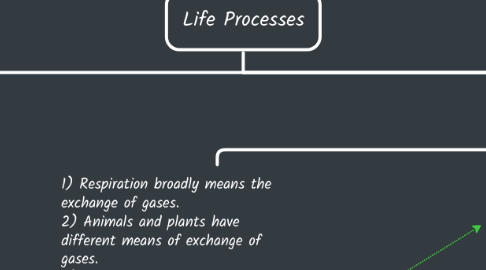
1. Nutrition
1.1. The process of acquiring food that is needed for nourishment and sustenance of the organism is called nutrition.
1.1.1. Autotrophic Nutrition.
1.1.1.1. If an organism can nourish itself by making its own food using sunlight or chemicals such mode of nutrition is called as autotrophic nutrition.
1.1.2. Heterotrophic Nutrition.
1.1.2.1. In this type of nutrition the organism cannot make its own food and get it from another.
1.1.2.1.1. Nutrition in Humans
2. Respiration
2.1. 1) Respiration broadly means the exchange of gases. 2) Animals and plants have different means of exchange of gases. 3) At a cellular level, respiration means the burning of food to generate the energy needed for other life processes. 4) Cellular respiration may take place in the presence or absence of oxygen.
2.1.1. Aerobic Respiration
2.1.1.1. 1) it takes place in the presence of oxygen. 2) The general equation of aerobic respiration as a whole is given below- Glucose + oxygen ⇒ Carbon dioxide + Water + Energy
2.1.2. Anaerobic Respiration.
2.1.2.1. 1) It takes place in the absence of oxygen. 2) End products maybe lactic acid(in muscles of animals) or alcohol(in some plants or organisms) .
2.1.3. Adenosine triphosphate (ATP)
2.1.3.1. 1) It is the energy currency of the cell. 2) ATP stands for Adenosine Tri-Phosphate. 3) This molecule is created.; as a result, reactions like photosynthesis, respiration etc. 4) The three phosphate bonds present in the molecule are high-energy bonds, and when they are broken, a large amount of energy is released. 5) Such released energy is then used for other metabolic reactions.
2.2. Respiration in Plants 1) Unlike animals and humans, plants do not have any specialized structures for gaseous exchange. 2) They have stomata (present in leaves) and lenticels (present in stems), which are involved in the exchange of gases. 3) Compared to animals, plant roots, stems, and leaves respire at a very lower rate.
3. Transportation
3.1. Transportation in Human Beings.
3.1.1. 1) Transportation in humans is done by the circulatory system. 2) The circulatory system in humans mainly consists of blood, blood vessels and the heart. 3) It is responsible for the supply of oxygen and nutrients and the removal of carbon dioxide and other excretory products. 4) It also helps to fight infections.
3.1.1.1. Heart
3.1.1.1.1. 1) The muscular organ which is located near the chest, slightly towards the left in the thoracic region. 2) The heart is the main pumping organ of the body. 3) The human heart is divided into four chambers which are involved in the transportation of oxygenated and deoxygenated blood. 4) The upper two chambers are called atria, whereas the lower two chambers are called ventricles.
3.2. Transportation in Plants
3.2.1. 1) Transportation is a vital process in plants. 2) The process involves the transportation of water and necessary nutrients to all parts of the plant for its survival. 3) Food and water transportation takes place separately in plants. 4) Xylem transports water, and phloem transports food.
4. Excretion
4.1. Excretion is the process of removal of metabolic waste material and other non-useful substances.
4.1.1. Excretion in Unicellular Organisms
4.1.1.1. 1) In unicellular organisms such as amoeba and bacteria, the waste product is removed by simple diffusion through the general body surface. 2) Unicellular organisms like the amoeba and paramecium excrete excess through tiny organelles called contractile vacuoles. 3) Undigested food in unicellular animals is excreted when the food vacuole merges with the general body surface and opens to the outside.
4.1.2. Excretion in human beings:
4.1.2.1. 1) Removal of harmful waste from the body is called excretion. 2) Many wastes are produced during various metabolic activities. 3) These need to be removed in time because their accumulation in the body can be harmful and even lethal for an organism.
4.1.2.1.1. Excretory System of Humans
4.1.3. Excretion in Plants.
4.1.3.1. 1) Cellular respiration, photosynthesis, and other metabolic reactions produce a lot of excretory products in plants. 2) Carbon dioxide, excess water produced during respiration and nitrogenous compounds produced during protein metabolism are the major excretory products in plants. 3) Plants produce two gaseous waste products, i.e. oxygen during photosynthesis and carbon dioxide during respiration. 4) The excretion of gaseous waste in plants takes place through stomatal pores on leaves. 5) Oxygen released during photosynthesis is used for respiration, while carbon dioxide released during respiration is used for photosynthesis. 6) Excess water is excreted by transpiration. 7) Organic by-products generated by the plant are stored in different forms in different parts. 8 ) The gums, oils, latex, resins, etc., are some waste products stored in plant parts like bark, stems, leaves, etc. 9) Eventually, plants shed off these parts. 10) A few examples of the excretory products of plants are oil produced from oranges, eucalyptus, jasmine, latex from the rubber tree, papaya tree, and gums from acacia. 11) Sometimes plants even excrete into the soil.
